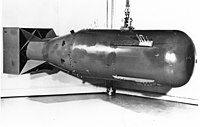
Photo from wikipedia
Introduction Subjects who undergo hematopoietic stem cell transplant (HSCT) are at increased risk for thyroid dysfunction. Few studies compare myeloablative (MAC) and reduced intensity (RIC) conditioning regimens. Objectives Describe the… Click to show full abstract
Introduction Subjects who undergo hematopoietic stem cell transplant (HSCT) are at increased risk for thyroid dysfunction. Few studies compare myeloablative (MAC) and reduced intensity (RIC) conditioning regimens. Objectives Describe the prevalence, incidence, and risk factors for thyroid disorder in pediatric and young adult subjects one year after HSCT after implementation of a universal screening program. Methods We performed a retrospective chart review of 167 subjects who were transplanted from June 2016 to August 2018 at CCHMC and underwent prospective universal late effects screening. One hundred forty-one subjects surviving to 1 year after HSCT were included. Results One hundred nine subjects had documented TSH values at least 9 months after HSCT. Median followup for screened subjects was 669 days (range, 271-1166). Subjects with documented TSH were similar to the overall cohort. Eight subjects had thyroid disorders prior to transplant, and ten developed thyroid disorders after transplant. Of these ten, none had chronic graft-versus-host disease (cGvHD), one had acute GvHD, and one had received TBI (Table 1). The median time to detection of a thyroid disorder was 430 days (range, 231-790) after transplant. One subject developed Hashimoto thyroiditis, one developed Graves disease, seven developed primary hypothyroidism without evidence of autoimmunity, and one developed pazopanib-associated hypothyroidism. This subject developed fatigue, prompting thyroid evaluation; however, the remaining nine patients were clinically euthyroid at diagnosis. Of the 31 subjects at risk who received RIC, 1 (3.2%) developed a new thyroid disorder, compared to 9 of 69 (13.0%) subjects who received MAC (p=0.167). Overall, 10.9% of subjects at risk for thyroid dysfunction after HSCT developed new disease. Conclusion Thyroid dysfunction remains a significant risk after HSCT, particularly after myeloablative conditioning. Annual screening beginning at one year from HSCT is recommended to improve early detection rates, especially since the majority of subjects detected in our analysis had no symptoms of new thyroid disease.
Journal Title: Biology of Blood and Marrow Transplantation
Year Published: 2020
Link to full text (if available)
Share on Social Media: Sign Up to like & get
recommendations!